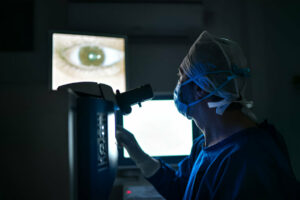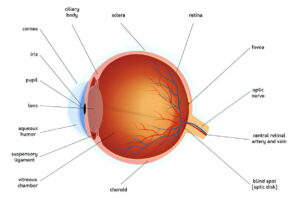
Blurry vision is an issue which may result from various conditions; most can be remedied easily using prescription eyeglasses or contact lenses.
Blurry vision can be a telltale sign of serious medical conditions. If it suddenly manifests, it is wise to consult your physician immediately.
1. Dry Eyes
Blurry vision can be an indicator of dry eye syndrome. This occurs when your tears don’t contain enough water, oil and mucous to adequately lubricate the surface of the cornea and keep its surfaces moisturized.
This condition typically results in itchy, burning, excessive tearing and red eyes. It’s especially prevalent among computer screen-gazing patients; however, chronic arthritis patients can also be susceptible.
Doctors can accurately diagnose dry eyes by asking you a series of questions and administering tests such as the Schirmer test (a small strip of paper placed in each corner of each eye to measure moisture on its front surface) or chemical testing for substances present in tear fluid. An ophthalmologist may then suggest various treatments including over the counter artificial tear solutions, prescription drops/ointments or eyelid massages; they may even insert small silicone plugs to stop their tears from draining too rapidly.
Other conditions that can contribute to blurry vision include allergies or viral or bacterial infections. Antihistamine eye drops and oral medications can provide some relief; additionally, using a humidifier in colder months and refraining from rubbing your eyes will help decrease dry eye symptoms. A diet rich in omega-3 fatty acids with limited caffeine consumption may also help alleviate symptoms.
2. Stroke
sudden symptoms such as blurry vision accompanied by severe headaches can be a telltale sign of stroke or transient ischemic attack (TIA). Stroke is a medical emergency, so anyone experiencing its main symptoms must seek immediate medical care immediately by calling 911 or the local emergency number and going directly to an emergency department as soon as possible.
Fuzzy or blurry vision accompanied by other warning signs of stroke can be easily recognized with the acronym B.E. F.A.S.T. This method involves looking out for one side of their face drooping when smiling; arms should also be raised to check if they drift downward; speech for any slurred or garbled language and time used as an indication.
Fuzzy vision can be caused by high blood pressure, cholesterol levels or diseases affecting brain blood vessels. Treatment options for such conditions include medication and lifestyle modifications; however, if left untreated early this can result in permanent loss of vision.
3. Glaucoma
Glaucoma is a family of eye diseases that causes damage to the optic nerve. The optic nerve lies at the back of each eye and transmits visual information from it directly to your brain so you can see. If left untreated, glaucoma can lead to blindness as high pressure inside of each eye can damage this vital component of our vision system.
Your eyes produce fluid to nourish and cleanse their interior surfaces, which usually drains out through a mesh channel. If you are suddenly experiencing blurry vision, this could be a telltale sign of too much intraocular pressure build-up within your eyes – open-angle glaucoma is one form of this disease; its most prevalent form, known as open-angle glaucoma, develops slowly over time with age as its drainage area gets blocked off and not enough fluid drains out, leading to intraocular pressure accumulation within that causes side-vision issues in peripheral vision – thus starting effects on peripheral (peripheral) vision impairment in side vision (peripheral vision impairment).
As glaucoma can develop quickly, regular eye examinations should be a top priority to detect it early. Unfortunately, early symptoms do not manifest themselves and thus it may take until serious vision loss to detect.
Your doctor can suggest several possible treatments for glaucoma and will choose the most effective approach for you. Most glaucoma patients are prescribed medication that helps lower eye pressure; either taken orally as pills or eye drops daily. An ophthalmologist will also conduct an exam that involves looking through your pupil to examine its shape and color of optic nerve, and test for high eye pressure using an instrument called a tonometer.
4. Macular Degeneration
Age related macular degeneration is a disease which leads to loss of central vision, making it hard to see straight ahead or recognize faces or objects. It is the leading cause of blindness for those over 50 in the US. Macular degeneration occurs when the central part of the retina called macula stops working properly resulting in blurriness and distortion in your central vision, providing only limited detail while making tasks such as threading needles or driving difficult or impossible.
Macular degeneration comes in two varieties – dry and wet. The former develops slowly over time and leads to gradual central vision loss; the latter occurs much more rapidly as fragile blood vessels form underneath the retina that leak blood and fluid into and around the macula, causing blurry and distorted vision that requires immediate medical care for severe vision loss.
Initial indicators of macular degeneration can include noticeable changes to your central vision, distortion of straight lines (such as window or door frames), decreased adaptability to low light conditions and difficulty following moving objects. It is wise to get an annual dilated eye exam so as to detect early stages of macular degeneration and monitor your eyesight accordingly.
A dilated eye exam involves inspecting the front of the eye including cornea, lens and vitreous humor – the clear gel inside. In addition, an optical coherence tomography (OCT) scan and fluorescein angiography examination may be conducted to ascertain any fluid build up beneath retina.
5. Pregnancy
Pregnancy hormone changes may result in temporary blurriness to vision during gestation. If this occurs for you, please notify your eye care provider to monitor it closely. Women who were diabetic before gestational diabetes and gestational diabetes should seek medical advice immediately if their vision becomes clouded, as it could indicate increased blood sugar levels.
Fuzzy or blurry vision accompanied by headache, sudden weakness, numbness on one side of the body or severe dizziness may be an early indicator of stroke and should be treated urgently by medical personnel. Furthermore, such symptoms could also signal preeclampsia – an imminent life-threatning condition marked by high blood pressure and protein in urine – which necessitate immediate medical intervention.
Most people experience gradual changes to their vision over time. Regular eye exams should be conducted to make sure your prescription remains up to date. Blurry vision can also be an indicator of other health conditions like multiple sclerosis or Parkinson’s disease, though sudden loss of vision should always be assessed promptly by a medical provider.












